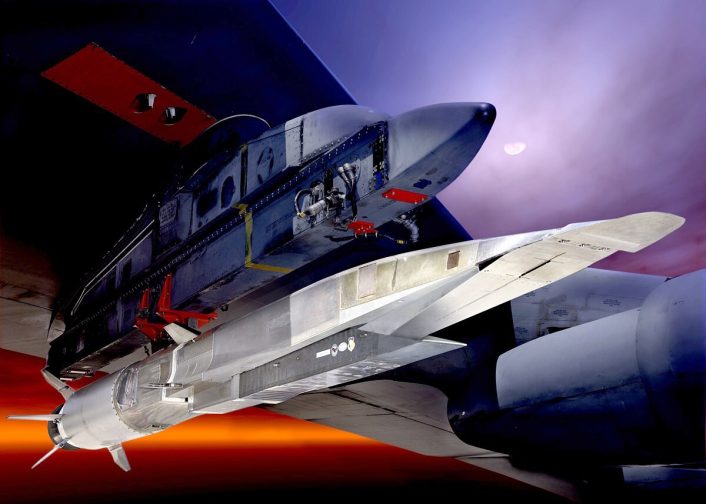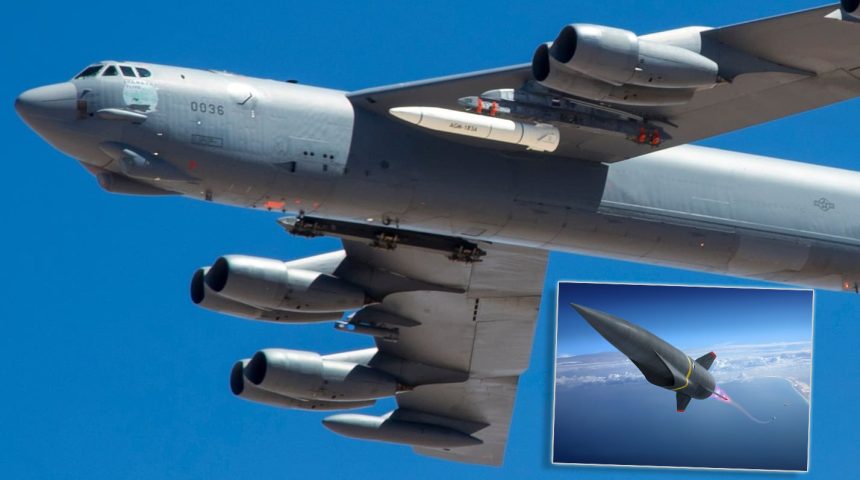Aviation Week Reports Hypersonic Missile “Believed to Have Inadvertently Separated” From B-52 Test Aircraft.
In a story on AviationWeek.com published on June 9, 2020, reporters Guy Norris and Steve Trimble reported that, “A scramjet-powered missile developed under the joint DARPA/U.S. Air Force Hypersonic Air-breathing Weapon Concept (HAWC) program was destroyed in a recent test accident, Aviation Week has learned.”
Norris and Trimble, both highly respected defense and aerospace journalists, went on to report that, “The missile is believed to have inadvertently separated from a B-52 carrier aircraft during a captive-carry flight test, according to sources familiar with the evaluation. The cause of the mishap, which is thought to have involved an aircraft from the 419th Flight Test Squadron at Edwards AFB, California, is under investigation.”
A May, 2019 report in NavalNews.com by Xavier Vavasseur said that, “Lockheed Martin’s Skunk Works team is developing this missile for DARPA, the U.S. Defense Advanced Research Projects Agency. Lockheed Martin would not disclose too many details, but a representative explained that this new missile draws from experience gained by the company with previous hypersonic projects such as HTV-2, a scale model of which was also present on Lockheed Martin’s booth at SAS 2019.”
While little information has been published from official sources about the ongoing U.S. hypersonic weapons program, there has been significant reporting (and speculation) in the media. The U.S. program is important since both Russia and China claim to have made significant progress in hypersonic weapons during the last five years. Russia claims that their Kh-47M2 Kinzhal or “Dagger” hypersonic missile has been “in service” since December 2017. Russian MiG-31 aircraft modified to carry the Kh-47M2 have been sighted by western journalists.

Hypersonic weapons are relevant since they offer a previously unavailable capability to reach targets around the world in very short time, even faster than previous ICBM systems. In his May, 2019 report in NavalNews.com, Xavier Vavasseur said that hypersonic missiles like the Lockheed Skunkworks Hypersonic Technology Vehicle 2 (HTV-2) tested in the DARPA Falcon Project, “Are capable of flying at Mach 17.53 or 21,000 km/h”. The project is apparently fairly mature according to Vavasseur “HTV-2 was flight tested twice, in April 2010 and August 2011. HTV-2 reached Mach 20 in both tests but lost telemetry earlier than planned.”
In 2013, LM released a concept image of the High Speed Strike Weapon (HSSW), “a hypersonic missile concept suitable for future bomber and fighter aircraft”.

Along with the scramjet-powered missile developed as part of the Hypersonic Air-breathing Weapon Concept (HAWC), the U.S. Air Force is testing the AGM-183A ARRW, a boost-glide hypersonic system being developed by Lockheed Martin. The strike weapon consists of a rocket booster and hypersonic glider warhead. After being launched from an aircraft, the booster rocket accelerates to high speeds before releasing the hypersonic glide warhead payload which then glides unpowered to its target at hypersonic speeds up to Mach 20.
There was no mention in today’s AviationWeek.com article from Norris and Trimble about how the information on the incident was obtained, but it is common for journalists to be constrained from publishing some sources over concerns that their sources may no longer provide information about breaking stories.










